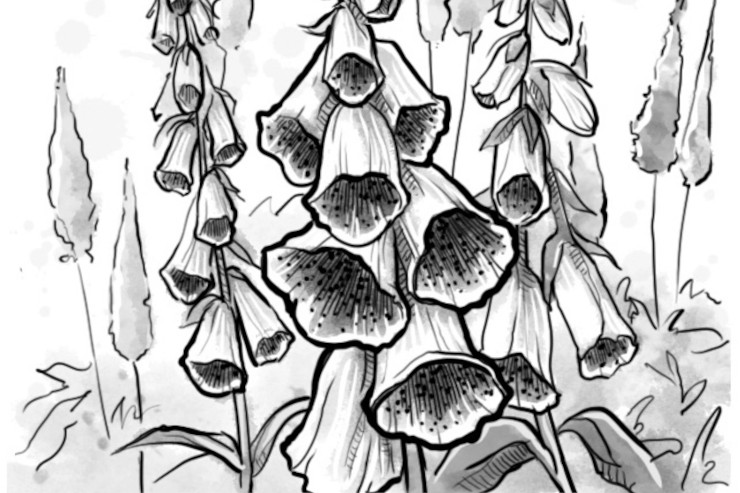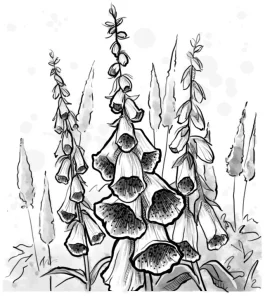
A Foxglove is a plant whose flower has petals joined together at the base. Foxglove flowers look like the fingers of a glove, or a bell, and are used as medicinal herbs topically, though not internally. The name comes, most likely from the term folks’-glove, meaning fairies’ glove, but it goes by many names, such as “bloody fingers,” “dead men’s bells,” “ladies’ thimbles,” “wild mercury,” and “fairy thimble.”
The stem of a Foxglove can produce up to 75 Foxglove flowers, which release up to two million seeds. They take some patience, as they won’t grow flowers the first year, but will bloom each year after with purple, white, or pink blooms.
Given how lovely they are, my guess is that the less enticing names came from folks who decided to eat the toxic Foxglove, rather than admire it. Foxglove isn’t toxic to touch, pick or even rub it on your skin, but eating it can cause a bit of distress. I don’t think we need to ask where the name “dead men’s bells” came from.
But that certainly isn’t the case for Rachel Lancashire, the author of today’s piece, “Dear Foxgloves,” who is their number one fan.
“Indeed, if any woodland creature wore gloves, it would surely be the stylish Vulpes vulpes,” she writes. “True, your flowers (flowerlets?) are far too small for fox paws, but never mind the size discrepancy—the name is perfect. One simply cannot love pinks or poppies, petunias or coneflowers the way that one can love a flower called foxglove.”
Oh, to be loved like a Foxglove!
Foxglove Flowers and Other Whimsical Gardens
This story comes from our archive that spans over 30 years and includes more than 130 magazine issues of GreenPrints. Pieces like these that inject the joy of gardening into everyday life lessons always brighten up my day, and I hope it does for you as well. Enjoy!

Dear Foxgloves
By Rachel Lancashire of Ennismore, Ontario

In truth, it was your name that first I fell in love with. Foxgloves—so utterly, gloriously Beatrix Potteresque! How could I but be enchanted by such a title? Indeed, if any woodland creature wore gloves, it would surely be the stylish Vulpes vulpes. True, your flowers (flowerlets?) are far too small for fox paws, but never mind the size discrepancy—the name is perfect. One simply cannot love pinks or poppies, petunias or coneflowers the way that one can love a flower called foxglove.
And you yourself are all your name promises: all elegance and old English charm, with just a touch of fairytale enchantment. I fully expect to find a pair of dapper field mice sipping tea beneath foxglove parasols on drowsy summer mornings, he in his top hat and monocle, she in her pearls and lace. And though they will bow and curtsy and vanish in a scurry when they see me, you will know, and I will know, and we will share this little garden secret.
In confidence I’ll share with you that I did wonder. I did waver. Was it wise to place a poisonous plant so near the mild-mannered kitchen herbs? Silliness, I know, but it did seem somehow wrong. But in the end, as you now know, it was not enough to stop me. (So you and I will share this, too, this tiny secret scandal.) It was love, after all. (And you were an heirloom!) (And hardy, too!) Truly, you are no insipid beauty. Even now, the rest of the garden frosted, snow dusted, and faded away, you stand in wondrous, verdant defiance. I cannot wait for next Summer’s gorgeous, stately spires (and—wink—the arrival of the well-dressed mice! ❖
By Rachel Lancashire of Ennismore, Ontario, published originally in 2019, in GreenPrints Issue #119. Illustrated by Chelsea Peters

Do you plant Foxglove flowers? Does this remind you of a similar story you’d like to share? Leave a comment below, I’d love to hear it.




I am 73 years old and have gardened all of my life having been raised on a farm. I start most of my flowers and vegetables from seed. This is the first year that I started foxglove from seed. While I was looking forward to next year’s blooms, I was pleasantly surprised to find a purple and a white foxglove blooming right now in September! What a delight!